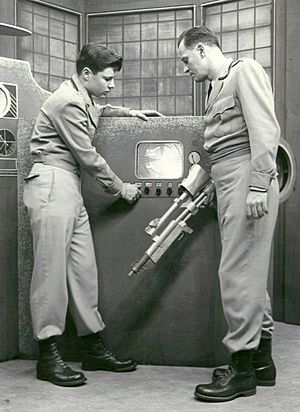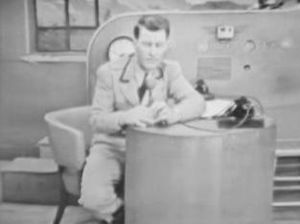Captain Video and His Video Rangers facts for kids
Quick facts for kids Captain Video and His Video Rangers |
|
|---|---|
 |
|
| Genre | Science fiction |
| Created by | Lawrence Menkin James Caddigan |
| Written by | Damon Knight James Blish Jack Vance Arthur C. Clarke Isaac Asimov Cyril M. Kornbluth Milt Lesser Walter M. Miller, Jr. Robert Sheckley J. T. McIntosh Robert S. Richardson< Maurice C. Brachhausen (M. C. Brock) |
| Starring | Richard Coogan Al Hodge Don Hastings Ben Lackland |
| Country of origin | United States |
| Original language(s) | English |
| Production | |
| Camera setup | Multi-camera |
| Running time | 24 mins. (1949-1953) 15 mins. (1953-1955) |
| Release | |
| Original network | DuMont |
| Picture format | Black-and-white |
| Audio format | Monaural |
| Original release | June 27, 1949 – April 1, 1955 |
| Chronology | |
| Related shows | The Secret Files of Captain Video |
Captain Video and His Video Rangers was an American science fiction television show. It was the very first science fiction series ever shown on American TV! It aired on the DuMont Television Network from June 27, 1949, to April 1, 1955.
The show was on almost every day, Monday through Friday, and sometimes even Saturdays. A special spin-off show, The Secret Files of Captain Video, also aired on Saturday mornings. Experts believe there were over 1,500 episodes in total. However, most of them no longer exist because old TV shows were often erased back then.
Many companies sponsored the show, like Post Cereals and Skippy Peanut Butter. They sold cool toys and prizes related to the show. Kids could get things like flying saucer rings, secret ray guns, rocket ship key chains, and plastic spacemen!
Contents
What Was Captain Video About?
This long-running show was set far in the future. It followed the exciting adventures of a group of heroes called The Video Rangers. They fought for truth and justice across the galaxy. Their leader was the brave Captain Video.
Who Were the Main Characters?
Captain Video led the team from a secret base hidden on a mountaintop. His uniform looked like a U.S. Army surplus outfit with cool lightning bolts sewn on. He always had a young sidekick, known simply as The Video Ranger. The Captain got his orders from "The Commissioner of Public Safety," who was in charge of the entire solar system!
Meet the Robot: I TOBOR
One of the most famous episodes featured a robot named "I TOBOR." This was the first time a robot ever appeared in a live science fiction TV show! The robot was originally named "ROBOT I." But the name was accidentally painted backward, creating the mysterious "I TOBOR." A very tall actor, David Ballard, played the robot.
The Villains Captain Video Fought
Captain Video faced many evil villains. One was Doctor Pauli, a tricky inventor. Another was Hing Foo Sung. Before he became a famous movie star, Ernest Borgnine even played a villain named Nargola on the show! It's estimated that about 300 different villains appeared over the years.
How Popular Was the Show?
Captain Video was broadcast live almost every day. It was very popular with both kids and adults. The famous comedian Jackie Gleason even mentioned the show in his sitcom The Honeymooners. In one episode, a character named Ed Norton wore a space helmet while watching Captain Video!
The show aired in the early evening, around 7 p.m. This gave parents a chance to get home from work and watch with their kids. In its last two years, each episode was shortened to 15 minutes.
Why Did They Show Cowboy Movies?
Even though the show was popular, it had a very small budget. To save money and fill time, about 10 minutes into each episode, a "Video Ranger communications officer" would appear. He would show about seven minutes of old cowboy movies! He called them adventures of Captain Video's "undercover agents" on Earth. It seemed a bit strange to mix space adventures with cowboys, but it helped the TV network save money.
Captain Video's Spaceships
Captain Video used different spaceships during the show. His first ship was the X-9. Later, he flew the "Galaxy," which looked like a V-2 rocket and had an aircraft-style cockpit. After 1953, his final ship was the "Galaxy II."
Who Played Captain Video?
The actor most people remember as Captain Video was Al Hodge. He played the role from 1950 to 1955. But the very first Captain Video was played by Richard Coogan for about 17 months. The young sidekick, The Video Ranger, was played by Don Hastings for the entire run of the show. Don Hastings later became a long-time star on the soap opera As the World Turns.
Cool Commercial Breaks and Prizes
During commercial breaks, the network aired special "Video Ranger messages." These were like public service announcements about being good citizens, or they advertised cool Captain Video toys. While the message played, the TV crew could quickly change the set for the next scene.
Many exciting prizes were offered by the show's sponsors. These included space helmets, secret code guns, flying saucer rings, and rocket models.
Where Are the Episodes Now?
Only a few episodes of Captain Video still exist today. The UCLA Film and Television Archive has 24 episodes. Only five of these have been released for people to watch at home. The rest can only be seen by appointment at the archive.
Sadly, most of the original recordings of the show were thrown away in the 1970s. No one knows exactly who ordered them to be destroyed.
Captain Video in Other Media
Captain Video's adventures weren't just on TV!
Movie Serial
Columbia Pictures made a movie serial called Captain Video: Master of the Stratosphere in 1951. It starred Judd Holdren. The movie had slightly better sets and special effects than the TV show. This was the only time a movie serial was based on a television program.
Comic Books
Fawcett Comics published six issues of a Captain Video comic book in 1951. Other popular space shows like Tom Corbett and Space Patrol also had their own comic books. Some of these comics were even used in a British book for Christmas, which predicted that humans would travel into space by 1970 and reach the moon by 2000!
Images for kids
See also
 In Spanish: Captain Video and His Video Rangers para niños
In Spanish: Captain Video and His Video Rangers para niños




